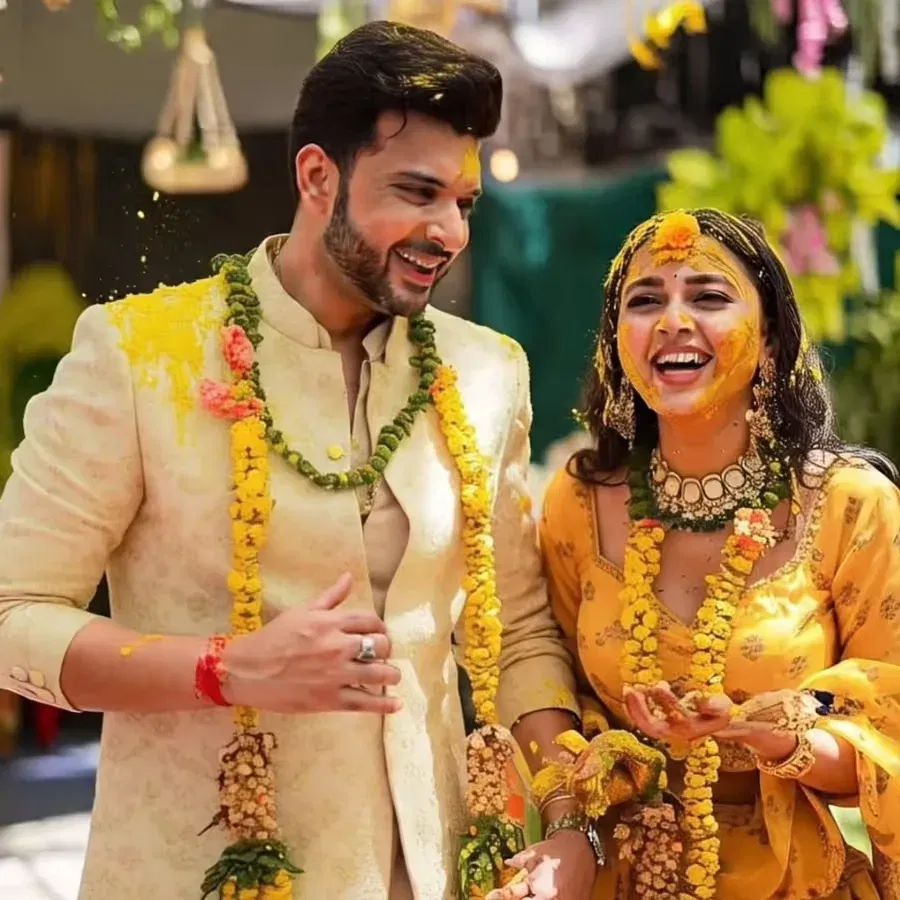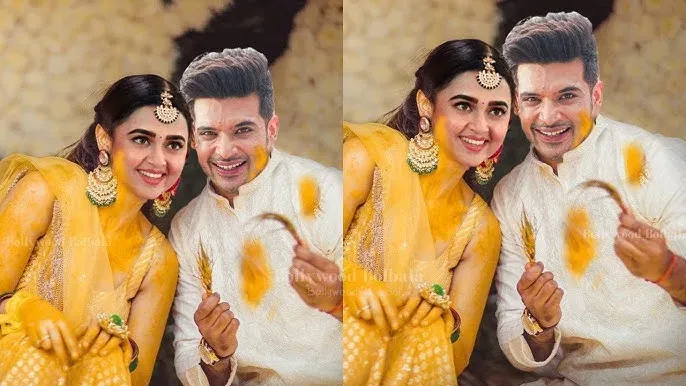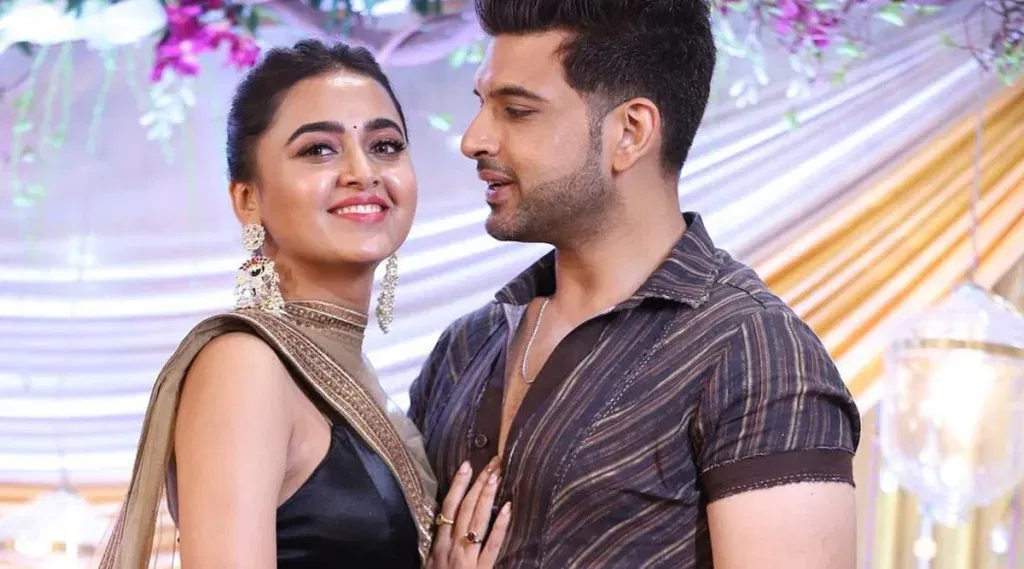Tejasswi Prakash Karan Kundrra Haldi Photos: AI-Generated Wedding Images Leave Fans Confused and Amazed
The digital age has brought unprecedented challenges to celebrity culture and fan engagement, Tejasswi Prakash and Karan Kundrra particularly when artificial intelligence technology intersects with entertainment industry speculation. Recent developments have highlighted how sophisticated AI-generated imagery can create convincing scenarios that blur the lines between reality and digital manipulation. Social media platforms have become breeding grounds for viral content that often spreads faster than fact-checking can keep pace, leading to widespread confusion among celebrity followers and entertainment enthusiasts.
The phenomenon has become particularly pronounced in the Indian television industry, where popular celebrity couples attract massive fan followings who eagerly await real-life relationship milestones and wedding announcements. This intersection of technology, celebrity culture, and social media dynamics has created a complex landscape where fans must navigate between authentic content and digitally created scenarios.
The rapid advancement of AI image generation tools has made it increasingly difficult for ordinary users to distinguish between genuine photographs and artificially created content, leading to situations where fake wedding ceremonies and relationship milestones can appear completely authentic to casual observers. Understanding these dynamics becomes crucial for both fans and industry observers who want to stay informed about genuine celebrity developments while avoiding the pitfalls of misinformation and digitally manipulated content.
The entertainment industry has witnessed a remarkable transformation in how celebrity content spreads across digital platforms, with recent incidents involving popular television personalities demonstrating the power and potential dangers of AI-generated imagery. These viral photos were actually created using AI technology, showcasing how advanced artificial intelligence has become in creating believable scenarios that can deceive even dedicated fans. The incident involving these particular television personalities highlights a growing trend where AI-generated content can create entire fictional narratives around real celebrities, complete with elaborate ceremony settings, traditional attire, and emotional moments that appear completely authentic to viewers.

The sophistication of modern AI image generation tools has reached a point where they can seamlessly blend real celebrity faces with fictional scenarios, creating wedding ceremonies, engagement photos, and other milestone celebrations that never actually occurred. These technologies utilize deep learning algorithms trained on millions of real photographs to understand lighting, composition, facial expressions, and cultural contexts, enabling them to produce images that are virtually indistinguishable from authentic photography. The result is content that can instantly capture the attention of millions of social media users, generating massive engagement through likes, shares, and comments from fans who believe they are witnessing real celebrity moments.
The impact of such AI-generated content extends beyond simple entertainment, as it can influence public perception, create false expectations, and even affect the personal lives of the celebrities involved. When fans encounter what appears to be authentic documentation of significant life events, they naturally respond with genuine emotional investment, congratulations, and speculation about future developments. This emotional engagement becomes problematic when the content is revealed to be artificially generated, potentially leading to disappointment, confusion, and erosion of trust between celebrities and their fan base.
The rise of AI-generated celebrity content represents a significant shift in how entertainment media is created and consumed, with implications that extend far beyond simple viral moments. Modern artificial intelligence systems can analyze thousands of photographs of celebrities to understand their facial features, expressions, and typical styling choices, then generate new images that place these individuals in entirely fictional scenarios. This technology has become so advanced that it can account for proper lighting conditions, traditional clothing styles, ceremonial settings, and even appropriate emotional expressions that would be expected in genuine photographs.
The process of creating such convincing AI-generated content typically involves several sophisticated steps, beginning with the collection and analysis of existing photographs of the target celebrities. Machine learning algorithms study these images to understand facial structure, skin tone, hair texture, and typical facial expressions, creating detailed digital models that can be manipulated and placed in new contexts. The next phase involves generating appropriate backgrounds, clothing, and ceremonial elements that match the intended scenario, whether it’s a wedding ceremony, engagement celebration, or other significant life event.
The technical sophistication required to create believable AI-generated celebrity content has become accessible to users with relatively modest technical skills, thanks to the development of user-friendly AI tools and platforms. This democratization of advanced image generation technology means that viral celebrity content can be created by anyone with internet access and basic computer skills, making it increasingly difficult for fans, media outlets, and even celebrities themselves to monitor and control the spread of fictional content about their lives.
The phenomenon of viral celebrity wedding speculation taps into fundamental human psychology regarding relationships, celebrity worship, and the desire to witness significant life milestones of beloved public figures. Fans of popular celebrity couples often develop strong emotional connections to these relationships, viewing them as representations of ideal romance and partnership. This emotional investment creates a natural desire to witness and celebrate major relationship milestones, making fans particularly susceptible to content that appears to document such events, even when that content is artificially generated.

The couple remains one of television’s most popular pairs, with fans eagerly following their relationship journey, which explains why AI-generated wedding content about them would generate such massive engagement and widespread sharing. The psychological appeal of celebrity wedding content stems from multiple factors, including the vicarious experience of witnessing love stories unfold, the satisfaction of seeing beloved couples achieve happiness, and the social bonding that occurs when fans share in collective celebration of these moments.
The rapid spread of such content across social media platforms is facilitated by algorithms that prioritize engagement over accuracy, meaning that emotionally compelling content often reaches wider audiences before fact-checking mechanisms can intervene. This creates a perfect storm where AI-generated celebrity content can achieve viral status within hours, accumulating millions of views and shares before the artificial nature of the content is widely recognized. The emotional investment that fans have in celebrity relationships makes them more likely to share what appears to be significant relationship news without taking time to verify the authenticity of the content.
The proliferation of AI-generated celebrity content raises significant concerns about privacy, consent, and the ability of public figures to maintain control over their personal narratives. When sophisticated AI technology can create convincing documentation of events that never occurred, celebrities face new challenges in managing their public image and protecting their privacy. The creation and spread of fictional wedding ceremonies, engagement announcements, and other personal milestones without the knowledge or consent of the celebrities involved represents a new form of digital privacy violation that existing legal frameworks struggle to address.
The impact on public perception can be particularly damaging when AI-generated content creates false expectations about celebrity relationships, career decisions, or personal choices. Fans who believe they have witnessed authentic documentation of significant life events may feel deceived when the artificial nature of the content is revealed, potentially damaging the trust and emotional connection that forms the foundation of celebrity-fan relationships. This erosion of trust can have real consequences for celebrities’ careers, as authentic content may be met with skepticism and reduced engagement from fans who have been repeatedly exposed to fictional narratives.
The challenge of distinguishing between authentic and AI-generated content becomes increasingly difficult as technology continues to advance, creating a landscape where both fans and media outlets must develop new skills and verification methods to ensure they are engaging with genuine celebrity content. This technological arms race between AI generation capabilities and detection methods represents an ongoing challenge for the entertainment industry, social media platforms, and the broader public who consume celebrity content.

The emergence of sophisticated AI-generated celebrity content has prompted the development of various detection and verification technologies designed to identify artificially created images and videos. These detection systems typically analyze multiple aspects of digital content, including inconsistencies in lighting, unnatural facial features, artifacts in background elements, and mathematical patterns that are characteristic of AI-generated imagery. However, the rapid advancement of AI generation technology means that detection methods must constantly evolve to keep pace with increasingly sophisticated artificial content.
Professional media outlets and entertainment platforms are beginning to implement verification protocols that include technical analysis of submitted content, cross-referencing with known authentic sources, and direct confirmation with celebrity representatives before publishing potentially significant content. These verification processes represent an additional layer of editorial responsibility that has become necessary in an era where convincing fictional content can be created with minimal technical expertise and resources.
The development of user-friendly AI detection tools has also become important for ordinary social media users who want to verify the authenticity of celebrity content before sharing it with their networks. These tools typically analyze uploaded images for telltale signs of AI generation, providing users with confidence scores and technical explanations about the likelihood that content is artificially created. However, the effectiveness of these detection methods varies significantly depending on the quality and sophistication of the AI-generated content being analyzed.
Fans can identify AI-generated celebrity photos by looking for several telltale signs that indicate artificial creation. Technical indicators include unnatural perfection in facial features, inconsistent lighting that doesn’t match the supposed environment, backgrounds that contain impossible or illogical elements, and clothing or jewelry that appears blurred or inconsistent. Additionally, fans should verify the source of the content by checking whether it comes from official celebrity accounts, verified news outlets, or reputable entertainment media sources. Cross-referencing the content with known celebrity schedules, locations, and recent activities can also help determine authenticity. Many AI-generated images also exhibit subtle artifacts around the edges of faces or clothing that become apparent under closer examination. When in doubt, fans should wait for official confirmation from the celebrities themselves or established media outlets before believing or sharing potentially significant content.
The rise of AI-generated celebrity content has far-reaching implications for the entertainment industry, affecting everything from fan engagement and celebrity privacy to media verification and public trust. Entertainment companies and celebrity management teams must now develop new strategies for monitoring and controlling fictional content about their clients, while media outlets must implement more sophisticated verification processes to maintain credibility. The phenomenon also raises questions about consent, as celebrities may have their likenesses used in fictional scenarios without their knowledge or permission.













